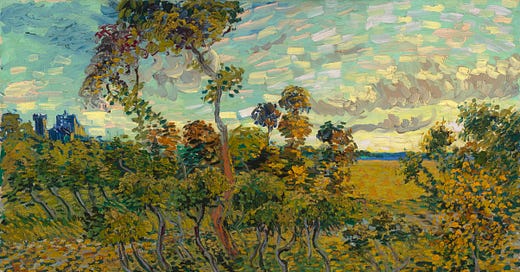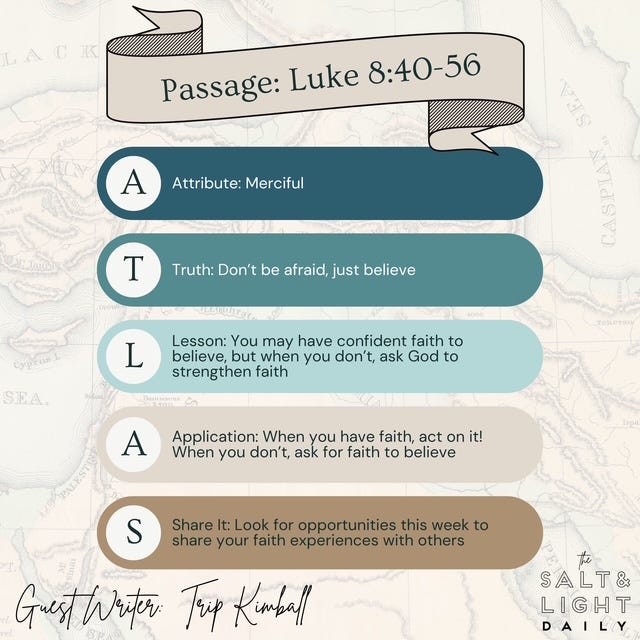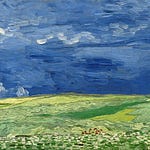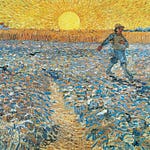Sunset at Montmajour 1888 Van Gogh
Hello Salt & Light Friends,
Join me in welcoming a guest writer/speaker in Trip Kimball this week. Trip has a wide range of ministry experiences including being a Pastor, Church planter, Published Author, and Missionary. Trip resides out of Jacksonville, Florida. I look forward to what Trip will bring to us in this next section of Luke.
Content is free for The Salt & Light Daily Substack.
We welcome and encourage paid supporters through Buy Me A Coffee.
Please consider a one-time or reoccurring donation to help us connect people to Jesus, the Bible, and a local church. This Substack is also an advocate to showcase guest writers to give them opportunities to practice the craft of writing for Jesus.
Thank you to these seven paid supporters through Buy Me A Coffee: Andrea Brown, Elliott Calvert, Greg with our Night Sky Substack, Landon Wallace, Morgan Pomfret, The Narrow Path Collective, & Todd Tallman.
We would also like to thank the ninety-five (95) substack publications recommending The Salt & Light Daily.

Today’s ATLAS Outline.
Jesus Raises a Dead Girl and Heals a Sick Woman
Now when Jesus returned, a crowd welcomed him, for they were all expecting him. Then a man named Jairus, a synagogue leader, came and fell at Jesus’ feet, pleading with him to come to his house because his only daughter, a girl of about twelve, was dying.
As Jesus was on his way, the crowds almost crushed him. And a woman was there who had been subject to bleeding for twelve years, but no one could heal her. She came up behind him and touched the edge of his cloak, and immediately her bleeding stopped.
“Who touched me?” Jesus asked.
When they all denied it, Peter said, “Master, the people are crowding and pressing against you.”
But Jesus said, “Someone touched me; I know that power has gone out from me.”
Then the woman, seeing that she could not go unnoticed, came trembling and fell at his feet. In the presence of all the people, she told why she had touched him and how she had been instantly healed. Then he said to her, “Daughter, your faith has healed you. Go in peace.”
While Jesus was still speaking, someone came from the house of Jairus, the synagogue leader. “Your daughter is dead,” he said. “Don’t bother the teacher anymore.”
Hearing this, Jesus said to Jairus, “Don’t be afraid; just believe, and she will be healed.”
When he arrived at the house of Jairus, he did not let anyone go in with him except Peter, John and James, and the child’s father and mother. Meanwhile, all the people were wailing and mourning for her. “Stop wailing,” Jesus said. “She is not dead but asleep.”
They laughed at him, knowing that she was dead. But he took her by the hand and said, “My child, get up!” Her spirit returned, and at once she stood up. Then Jesus told them to give her something to eat. Her parents were astonished, but he ordered them not to tell anyone what had happened. - Luke 8:40-56
A Tale of Two Miracles
Hello Readers & Listeners,
Life is not random. Neither are the stories in the Bible. The stories we read in the Bible are highlighted by God’s Spirit, as He directed them to be written (2nd Peter 1:21). The Bible is honest. Sometimes, it’s honesty shocks us. There are plenty of sensational and graphic stories throughout the Bible to offset the miracles found in the Gospels.
The stories in the Gospels have a God-ordained purpose. The Gospel of Luke gives us a comprehensive narrative of the life of Jesus. It begins with His birth, even His conception, by the Holy Spirit. It culminates with the Lord’s resurrection from the dead and His final instructions to His followers. The two stories of miracles in our selected text may seem unrelated, but they intersect with faith in Jesus. But their similarity ends there. They are a study in contrasts.
At the beginning of this story, a crowd presses in around Jesus and His disciples when Jairus, a ruler of the synagogue, comes and falls at Jesus’ feet. This scene is extraordinary. Jairus was an important leader in the synagogue, yet he bowed at the feet of Jesus and pleaded for his dying daughter. Intent on getting the Lord’s attention, he ignores the crowd.
Responding to Jairus’ passionate request, Jesus sets out for his home. As the crowd swarms around them, the story is interrupted by a woman with a chronic bleeding disease. She reaches out to touch Jesus’ robe, and her twelve-year hemorrhage stops! At this, Jesus also stops. He wants to know who touches Him.
Here’s our first significant contrast. Jairus, the important religious figure, openly pleads with Jesus amid the throng of people. The unnamed woman, who is ceremonially unclean according to the Law of Moses because of her bleeding, tries to stay unnoticed by Jesus and the crowd.
Her reluctance to acknowledge touching the robe of Jesus shows her awareness of her uncleanness (see Leviticus 15:25-27). She knows it is not allowable for her to touch Jesus or any of His clothing. She sees Jesus as a righteous man whom she ought not to approach. This is why she trembles at His feet when she tells of her condition.
Notice how Jesus brings attention to her and her healing. “Someone touched me; I know that power has gone out from me.” (Luke 8:46) Why do you think Jesus would do this? The answer is revealed in verse 48—“Daughter, your faith has healed you. Go in peace.”
Once again, the story is interrupted. While Jesus encourages this unnamed woman, someone comes to report the sad news of the death of Jairus’ daughter. Consider how heartbreaking this scene is for Jairus. Right after the miraculous healing of this unclean woman, he’s told, “Your daughter is dead,” he said. “Don’t bother the teacher anymore.”
Of course, this does not deter Jesus. It’s not the end of the story. He tells Jairus, “Don’t be afraid; just believe, and she will be healed.”
When Jesus arrives at the home of Jairus, only Peter, John, and James are allowed to go into the home with Him and the parents. This brings another set of contrasts. The crowd of wailing people is shut out. It’s a very intimate setting compared to the previous miraculous story of the woman in the crowd. Not only that, but Jesus stuns the people with His rebuke and declaration—“Stop wailing,” Jesus said. “She is not dead but asleep.”
Jairus and the woman both approach Jesus with reverence, but this crowd mocks Him. They laugh at Jesus, thinking they know better than He that the girl is dead. Their life experience and reason block out any sense of faith on their part.
Isn’t this just like us so often? Our human reason and life experience limit our capacity to trust in God. It can quench our faith.
My own miracle story
In 2009, I was diagnosed with cancer. I was hesitant to share this with the men’s group I led and taught. My immediate family knew, of course, but I didn’t want well-intentioned prayer from the men. Let me explain what I mean.
As a pastor, I’ve prayed for and with hundreds, maybe thousands, of people over many years. Too often, I’ve heard people pray something like, “Lord, if it is your will, … heal, help, etc.” It’s not the words but the sense of fatalism I hear in so many people. Well, all we can do is pray, as if it’s a last resort rather than an expression of faith. Fate is the antithesis of faith.
When I finally shared my need for healing with the men’s group, I exhorted them about this. I told them I didn’t want shallow, well-intentioned prayers. Of course, I got immediate pushback on this. I expected it.
I asked the men to pray in faith in a similar way to what Jesus told Jairus. Just believe. Here’s how Jesus instructed His disciples about this: “Have faith in God,” Jesus answered. “Truly I tell you, if anyone says to this mountain, ‘Go, throw yourself into the sea,’ and does not doubt in their heart but believes that what they say will happen, it will be done for them. Therefore I tell you, whatever you ask for in prayer, believe that you have received it, and it will be yours” (Mark 11:22-24).
I exhorted the men to ask God for faith to believe if they didn’t have it. How often do human reason, life experience, and the unbelief of others interfere with our faith? Faith is simply trusting God. It’s not complicated. Jesus told His disciples their faith needed to be like a child’s (Luke 18:17). This is what I see with both the unnamed woman and Jairus. But even their level of faith in Jesus seemed different.
One final contrast I see is with how Jesus addressed the aftermath of the two miracles. Jesus told the parents, “Not to tell anyone.” And yet, Jesus made a point to reveal the faith and healing of the woman. Why would He do this?
I’ve learned to be content with not knowing all the inner workings of faith, miracles, and the many “why” questions we could ask God. That’s not to say I’ve never asked God “why” about certain situations in life. I have. I don’t dismiss reason, but I’ve come to realize the difference between my attempt to figure things out and trusting God.
God’s wisdom transcends human wisdom.
The apostle Paul points out to the Corinthian church that God’s wisdom transcends human wisdom (1st Corinthians 1:25). Likewise, faith in God is greater than human reason. God chose faith as how all people may know Him. He calls us to trust Him more than our reason.
What about you?
Do you place more confidence in faith or human reason and wisdom?
The point of these two miracles is to remind us how the Kingdom of God transcends the kingdom of this world.
When God gives you faith to believe. Act on it with full trust in Him. If you find your faith faltering when you pray for someone or something like God’s guidance or provision, fall at His feet in prayer. Ask Him to strengthen your faith, even give you faith to overcome any unbelief you might have.
References/Resources:
Sunset at Montmajour, 1888, Vincent Van Gogh
Attribute: Merciful - God in His mercy does not give us what our sins deserve. He limits the extent of pain. He restrains evil and holds back sin. He makes His gospel known in places where people have turned their backs on Him. God seeks those who are lost, alone, hurting and in need. He forgives and restores those who repent and turn to Him in faith. References to this attribute: Nehemiah 9:31, Proverbs 28:13, Psalm 78:38, Psalm 145:8, Luke 6:36, James 2:13, and 2nd Peter 3:9.
Parallel passages to Luke 8:40-56: Matthew 9:18-26, Mark 5:22-43.
Buy Me A Coffee, Go to Buy Me A Coffee.com / The Salt and Light Daily or click the link below.
More about Trip Kimball:
Published Author with Books on Amazon.


















Share this post